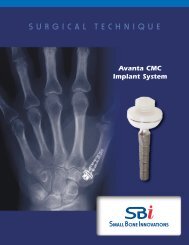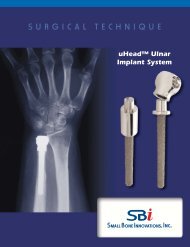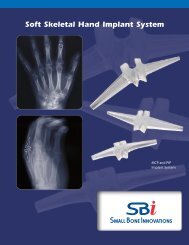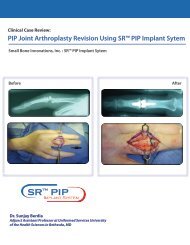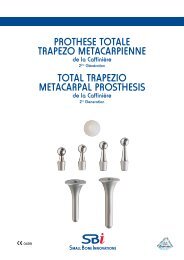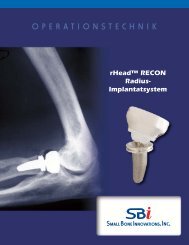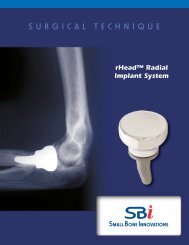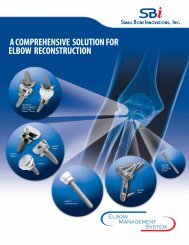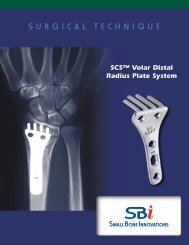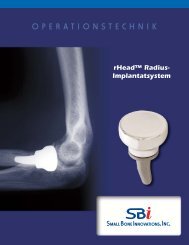PGT INSTRUmENTATIoN - Small Bone Innovations
PGT INSTRUmENTATIoN - Small Bone Innovations
PGT INSTRUmENTATIoN - Small Bone Innovations
You also want an ePaper? Increase the reach of your titles
YUMPU automatically turns print PDFs into web optimized ePapers that Google loves.
Final Tibial Preparation<br />
Height Adjustment Pin<br />
Use the ruler to measure the anterior-posterior dimension of the<br />
cut surface of the tibia. Determine the appropriate size of the tibial<br />
component such that the component will rest on cortical bone on<br />
both the anterior and posterior aspects of the tibia. (TABLE 2)<br />
Tibial Components<br />
X-<strong>Small</strong> <strong>Small</strong> Medium Large X-Large<br />
Width 30 32 32.5 33 33.5<br />
Depth 30 30 35 40 45<br />
Table 2<br />
Width<br />
Anterior<br />
Figure 41<br />
Depth<br />
Posterior<br />
The tibial size chosen is independent of the talar component size.<br />
The corresponding barrel guide is placed against the prepared tibial<br />
surface in the position that gives best anterior and posterior cortical<br />
coverage. The barrels need to be lined up in the M/L plane to be<br />
centered over the talar component. (FIGURE 41) A joint spacer, poly<br />
trial, or joint distractor may be used to apply pressure to the tibial<br />
barrel guide to keep it flush against the prepared tibial surface. (The<br />
bearing trial allows easier access for drilling the barrel holes.) The<br />
height adjustment pin is used to help stabilize the barrel guide while<br />
it is pinned with 2.4 mm pins. The barrel holes are drilled down to<br />
the stop using the 6.5 mm drill bit. After drilling the first barrel hole,<br />
place the barrel hole plug in the hole to insure precise spacing as the<br />
second hole is prepared. After drilling the barrel holes, the key hole<br />
broach is inserted into the barrel hole guide to remove the excess<br />
bone between the barrel hole and the distal tibial surface. (FIGURE<br />
42)<br />
All of the talar and tibial preparation is completed at this point. One<br />
can now assess the balance of the joint, and ligament tightness by<br />
doing trial reductions using the trial bearings.<br />
Figure 42<br />
16<br />
S.T.A.R. ® Scandinavian Total Ankle Replacement Surgical Technique



